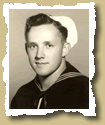| The Assault | Timeline | Maps | Men of D-Day | Photos |

|
Like so many G.I.s that day, I was on my way across the English Channel early on the morning of June 6, 1944. I was aboard LCI(L) 553 that was commissioned in Perth Amboy, N.J. on February 15, 1944. We left Norfolk, Va. after training for 6 weeks on March 24, 1944. I did not know then that I had chronic seasickness. After 13 days on April 5 we landed in the Azores Islands and I had lost 35 pounds. We left the Azores on April 7 and landed in Falmouth, England on April 12. Then on April 17, 1944 we engaged in T-6 Exercise Tiger practice landings at Slapton Sands and I never knew about the loss of life; that night LSTs were torpedoed by German subs. This brings D-day June
6, 1944. My battle station was the stern winch an I let the anchor go when told. We unloaded the 29th Engineers without a hitch and the order was given to retrieve the stern anchor but it never grabbed ahold and I retrieved it and secured it. Then LCI 555 came in and shot a line in 3 times but the wind was so strong the line did not reach us. The Executive Ensign Milliken dove into the water and retrieved the line but LCI 555 could not shake us and since the German 88 had gotten our range, the Captain cut the LCI 555 loose to get them out of danger. Captain Don DuBrul saw to it that Ensign Milliken was awarded the bronze star. I was sent to the engine
room to secure the generators and engines and watch for fire. Scottie
(Roland Scott) the QM had gone to the engine room with me. Everyone
abandoned ship and took cover on the beach. A few minutes after
they left we came up from the engine room and we went on the beach.
He went one way and I went the other. I crawled under a half track
and coxswain Stephens was there. Sometime after midnight
we got underway and landed in Portland, England at a British base
and given more clothes and a shot of rum. We were driven by truck
to Plymouth on June 8. As far as we knew Stephens and I were the
only survivors but then we got orders and were moved to Vicarage
Barracks on June 20 with the rest of the crew. Two shipmates were
in the hospital. Stephens and I may have made a wrong move leaving
the beach, but we were alive. Robert M. Leach LCI 553 MOMM/3 (May 07, 2001) |
| |
